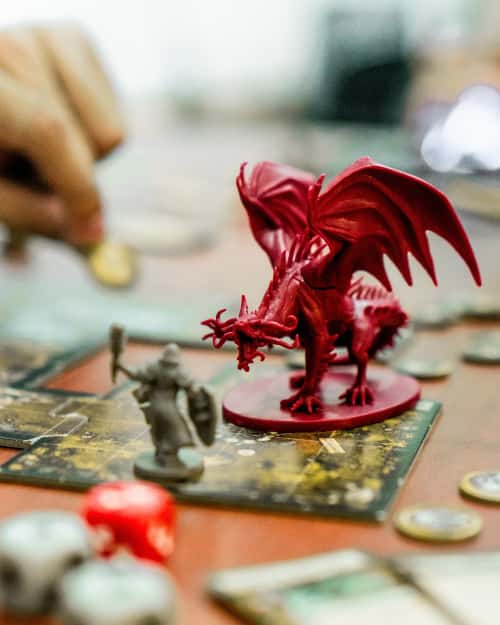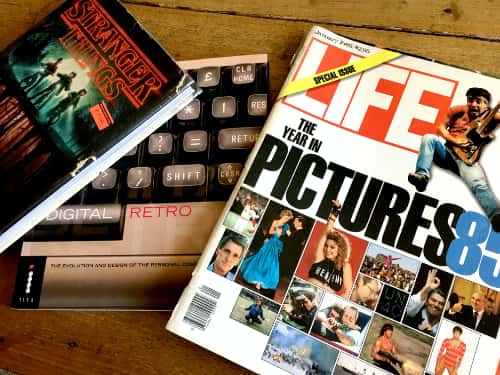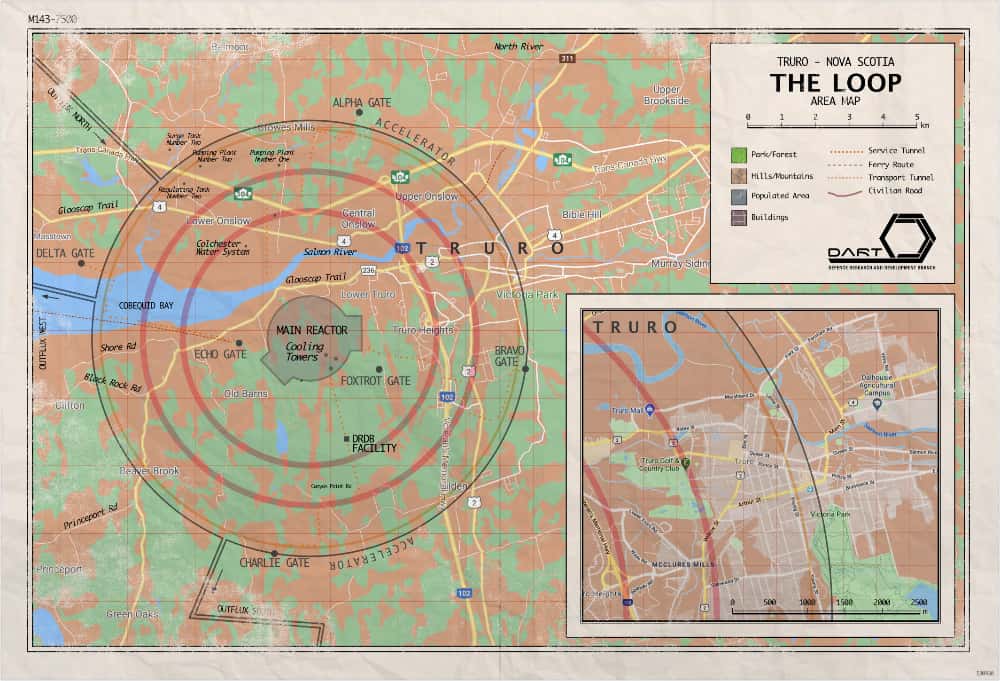Tales from the Loop – The Familiarity of an Alternate Universe
Returning to gaming has also meant a return to the 80s – or more accurately, to the retro future of Tales from the Loop – for artist, writer, father, and GM Wouter Goedkoop.
Guest post by Wouter F. Goedkoop
The worlds we explore during our tabletop gaming sessions are often imaginary ones. Some have historical or mythical groundings in the real world. They can take place during the Hyborian Age, the Third Age, the Roaring Twenties or a post-apocalyptic future. Others, on the other hand, are limitless high fantasy worlds such as the Forgotten Realms or the Star Wars universe.
Whichever you enjoy most is a matter of taste. The game mechanics have to be a good fit for your group’s play style and facilitate the storytelling experiences you long for. Rules aside, another defining aspect of a good tabletop role-playing game is its world building and its ability to present you with an inspiring sandbox.
Gateways to Fantasy Worlds

Often, the setting will be a defining factor when you are first presented with a game, be it as a player or a game master. The world and its premise welcome you first. Through that portal you make your way to the meat of the game. The rules are what hold it all together and they will empower you to live extraordinary moments of shared storytelling with your gaming group. The shear variety offered by our hobby’s landscape – today as much as during its first golden age – ensures that there are games out there for all of us.
I don’t think there are many bad games that suffer from terrible game mechanics, either. The trick is to find the one that suits you and the people you play with. The first TTRPG I ever played back in the mid eighties was The Dark Eye. It introduced my friends and I to a plethora of others: Call of Cthulhu, Paranoia, MERP, Star Wars, Ghostbusters, Pendragon, Stormbringer and of course, D&D. Over a period of five years, we played with a lot of systems, set in as many different worlds and genres. What followed eventually was a long hiatus, which is not uncommon for tabletop role-players. Years later, it was Dungeons & Dragons 5th edition that slowly pulled me back in.
Much to Explore
To cut a long story short (those tales can be found elsewhere), I quickly found myself attracted to other games than just the old ones I still owned. Aside from D&D 5E which served as a wonderful portal to this new era of gaming, two in particular really impressed me: Adventures in Middle Earth and Tales from the Loop. The first one gave me the opportunity to explore my absolute favourite high fantasy setting while the second one tapped into something different entirely.
I have always had a soft spot for the kind of storytelling that gives you room to contribute to the world, or the background information that is not covered by the author. This applies to books, films and games. Some people like to know everything about a set of characters or a premise. Others enjoy thinking about a tale long after it has ended. Reflecting on all the unknowns and all the questions left unanswered is as enjoyable for me as the story itself. Books, movies and games with this approach to storytelling can provide very powerful means of broadening one’s horizons.
Mystery is Not a Plot Hole
The idea of no being given all the pieces of the puzzle is very stimulating because it asks something in return. Come to think of it, tabletop role-playing games are all about contributing to the story. How much you eventually find out is up to you, the game master and the other players. If you enjoy your adventures bathed in mystery, keep it like that. If your group wants every storyline to end, nicely tied in a bow, do that in the most rewarding way possible. The only right way to play is by having fun and the key to a great game is to tell stories that matter to you!
When I rediscovered the role-playing hobby, I dove back in because of curiosity. Soon enough, though, I had a new group of heroes that were waiting to go on their first tabletop adventures: my kids. We have spent the last two years playing D&D. Its modernized ruleset is versatile enough to cater to many different situations and storytelling devices. The setting was also something that got them excited right from day one. Dungeons and Dragons, just like Pathfinder, does offer a setting that can easily be tweaked to fit most players’ preferred flavour of high fantasy.
Cinematic Inspiration
Alongside our adventures on the tabletop and my kids’ own passion for reading, I have also taken the time to fuel their thirst for fantasy by introducing them to pop-corn movie classics that I feel are essential viewing. They were already familiar with Star Wars, The Lord of the Rings & Harry Potter adaptations, as well as Dark Crystal and other Labyrinths. The time had come to tackle more ‘realistic’ films with a lighter tone.
Seeing how much they enjoyed WarGames, Ghostbusters, E.T., The Karate Kid and many more, my wife and I decided to watch Stranger Things again, with them this time around and see how that would go. It was really interesting to observe how it challenged their ideas of storytelling. It was also a fun way for them to see what the ‘80s were sort of like and it made my childhood so much more relatable.
It seemed only logical that I would tell them about the latest role-playing game I had acquired: Tales from the Loop. A quick explanation of the game’s setting and premise was met with definite high amounts of exultation! As for me, I was looking forward to diving into a new system with an open mind, casting aside any preconceptions.
Shared Storytelling
In any TTRPG, character creation is always a highlight, and with Tales from the Loop, it sets the tone right away. The rules being simple and to the point, I was able to explain them while we created our characters. Since our group is small, I will often play an additional party member (or two) as an NPC to balance things out and give the story a push if needed. I wasn’t planning on it this time around but the kids insisted and it actually made a lot of sense, in regards to how the characters in the game would know each other and also in the context of the game mechanics.
Contrary to games like Dungeons & Dragons, Tales from the Loop does not put the Game Master in the storytelling high chair. The mysteries are made up of a general leading thread that only the GM knows of, yes, but everyone around the table contributes ideas, scenes and other devices to the mystery as it unravels. There is no storytelling burden carried by a single person, instead, it becomes a shared experience. The game master acts more as a guide, having the final say only when absolutely necessary.
High-Concept Sci-Fi
As the game so eloquently puts it, the adventures take place in “the ‘80s that never were”. The campaign found in the core rulebook (which we started with) takes place in either one of two settings: the Mälaren Islands in Sweden or Boulder City, Nevada. Game masters are however encouraged to set it in a more familiar setting. This seemed like a great idea as it would provide the kids with a more substantial grounding and points of reference they could easily use. The game already takes a spin on reality by placing it in an alternate universe where technological breakthroughs have made a huge impact on everyday life. The existence of the Loop, a large particle accelerator, and other technologies discovered decades prior, allow for many unusual situations and events that have the potential to turn the stories into high concept science fiction mysteries instead of simply indulging in retro nostalgia self-servicing.

The way I approached it was to use the twists and enigmatic qualities of the mysteries as a wow factor and the 80s nostalgia as a way of making it as grounded in reality as possible. Using my wife’s home town here in Nova Scotia as a setting made way more sense than any other place for us. I have been visiting it for over 20 years and the kids have been there every summer since they were born. Having a good geographical familiarity with the town helps tremendously in creating an immersive experience. But how did it look back in 1984? What did it feel like? While I could possibly rely on my local relatives’ memories, it would prove time consuming. The last thing I wanted was to spend a year amassing enough research. Sometimes, stories cross paths in the most unexpected way and suddenly I recalled something I saw on YouTube just over a year ago.
Historical Accounts
It was a home video shot in 1985 by two buddies who wanted to show their college friends what their home town was like (the Chronicle Herald wrote a short article about how the video resurfaced online and how it sparked the interest of the locals, you can read it here. It’s a very cool historical and visual account of a time gone by. It served my purposes wonderfully.

Useful inspiration can be found in old magazines of the times you are traveling back to, reference books about technology, fashion or architecture, or pseudo retro fantasy fare.
I have a certain interest in learning about a place’s history and I find things like old maps, flyers, brochures and other memorabilia fascinating. I will definitely be looking more into the past of our region to learn more about it. For now, the internet is helping me a lot to flesh out the eighties that never were of our local setting.
The video and other items I found while researching online gave me visual references and insight into the businesses that existed back then, and other useful pointers. This all became handy in describing venues and buildings during our play sessions. The kids could easily relate to where they were and where to go to next in the context of the story and the area’s topography.
Being a cartographer pushed my desire to create more immersive tools for our adventures and thanks to another technological wonder of our time (Google Maps), I was able to create a map similar to those found in the game’s rulebook. It makes for a handy tool to use during play to keep track of distances and time spent covering them. I don’t let it dictate the pace of play or bog down the fun, I just like to glance at it for reference.

As someone who experienced the ‘80s firsthand, I can recall moments or feelings of my youth, making it easier to reconnect with how kids see the world at age 11. Music is definitely a great way of tapping into those feelings as well as other small items that have survived the passing of the years. For example, I still own the Casio watch I received on my 10th birthday. It’s silly but I keep it handy when we play this game. It reminds of that place full of wonder, thrill, boredom, excitement, frustration and danger, where incomprehensible grown-ups, annoying siblings and great friends all co-exist.
Using Player Feedback
Compared to my trip back in time, the kids obviously had a different experience. Between the familiar setting and their knowledge of what made the ‘80s so different from a daily life stand point, they were perfectly at ease with the fact that they were playing in a, so to speak, period piece with a science fiction twist. I do like to get their feedback after a few sessions to find out what they enjoyed and what they found boring or a drag. With a rule system like Tales from the Loop, it’s easy to tailor the experience to your group’s tastes because the narrative takes centre stage. Here’s what they had to say:
Kid one (11 years old):
“I liked how we can all create the story together. It feels as though we have more freedom to do whatever we want than in D&D. I would like the next adventures to have more technology, decoding stuff and riddles. Also, can we go to a beach?”
Kid two (13 years old)
“I like that it takes place in the 80s because you get to do what they did. I also like the fact that you can do anything you want. I wish some of the characters weren’t so annoying. One more thing: Do we get to play in school during our next adventure (because there’s other kids)?”
This feedback is extremely helpful. While some remarks are targeted directly at their sibling, most of it hints at how I can make the game better for them. It’s not so much about giving them want they want as it is to poke around a little more to find out what makes them tick. If you know what they enjoy and what feels familiar, you’ll find more powerful devices to get them out of that comfort zone and surprise them more when the tale takes an unexpected turn. I don’t mean to do this in an uneasy or upsetting way, on the contrary. Having to deal with unusual circumstances in TTRPGs should be thrilling and help players to think outside the box.
Storytelling can be many things, and tabletop role-playing games offer an extremely wide array of delivering unique narratives. Everyone brings something along that contributes to the story. Even though you might be treading on familiar ground because of the setting or the general direction of the adventure, it’s likely you’ll end up in places you would not have discovered on your own. Don’t be afraid of venturing off the beaten path and exploring the possibilities of something new. You’ve made it this far, your adventures are only just beginning!
Ω
Wouter F. Goedkoop is a multi-faceted designer, artist and storyteller who, after living across Europe decided to find his home in Nova Scotia where he lives with his wife and kids. At the Voyager’s Workshop, he creates fantasy art products for people who enjoy adventures of pen, paper, cardboard and pixels.